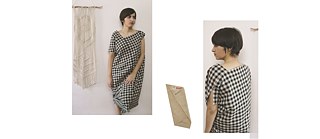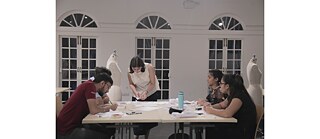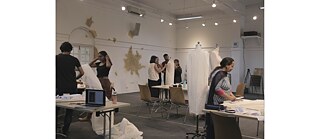About the Actant
 © Pragya Sharma
Pragya Sharma is a fashion designer based out of Gurgaon, India. She is currently working as a design lecturer at the Indian Institute of Art and Design, Delhi. Prior to teaching, she worked as a menswear designer. Initially trained as an engineer, Pragya moved to fashion design; this blend of a technical subject together with design gives her practice a distinct touch and sensibility. Other than teaching, Pragya manages a small enterprise with her mother called ‘Unpurl’, where they along with other women, do hand-knitting and crocheting, develop accessories and other winter products, as well as teach people knitting by organising collective workshops. Pragya works on different zero waste projects, exploring not just how to reuse the existing waste but also different possibilities to creatively design around waste.
© Pragya Sharma
Pragya Sharma is a fashion designer based out of Gurgaon, India. She is currently working as a design lecturer at the Indian Institute of Art and Design, Delhi. Prior to teaching, she worked as a menswear designer. Initially trained as an engineer, Pragya moved to fashion design; this blend of a technical subject together with design gives her practice a distinct touch and sensibility. Other than teaching, Pragya manages a small enterprise with her mother called ‘Unpurl’, where they along with other women, do hand-knitting and crocheting, develop accessories and other winter products, as well as teach people knitting by organising collective workshops. Pragya works on different zero waste projects, exploring not just how to reuse the existing waste but also different possibilities to creatively design around waste.
 © Pragya Sharma
The CMT (Cut, Make, Trim) waste generated during the construction phase of garment-making contributes to 10-20% of fabric wastage. It is a significant amount considering the pace at which the fashion industry is currently operating. Little of this waste is utilised, instead it is incinerated or ends up in landfills, taking hundreds of years to degrade and emitting toxins into the environment in the process. Using an approach called DPDC, a synthesis of designing, pattern-making, draping and cutting, Pragya has explored zero waste fashion. Inspired from cubism, in particular ‘Still Life with bottles and knives’ by Juan Gris and taking reference from step-by-step origami, using only a rectangle or a square paper as the starting point, the translation of folds from paper to fabric leads to interesting discoveries in terms of silhouettes, garment openings using slashes, etc. The square fabric is patchworked using waste fabric of similar tints and tones, or end-of-rolls from retail shops. This technique offers production and financial incentives in fabric utilisation. Since the construction of the garment follows a very simplistic approach, it moulds in accordance to the wearer’s body.
© Pragya Sharma
The CMT (Cut, Make, Trim) waste generated during the construction phase of garment-making contributes to 10-20% of fabric wastage. It is a significant amount considering the pace at which the fashion industry is currently operating. Little of this waste is utilised, instead it is incinerated or ends up in landfills, taking hundreds of years to degrade and emitting toxins into the environment in the process. Using an approach called DPDC, a synthesis of designing, pattern-making, draping and cutting, Pragya has explored zero waste fashion. Inspired from cubism, in particular ‘Still Life with bottles and knives’ by Juan Gris and taking reference from step-by-step origami, using only a rectangle or a square paper as the starting point, the translation of folds from paper to fabric leads to interesting discoveries in terms of silhouettes, garment openings using slashes, etc. The square fabric is patchworked using waste fabric of similar tints and tones, or end-of-rolls from retail shops. This technique offers production and financial incentives in fabric utilisation. Since the construction of the garment follows a very simplistic approach, it moulds in accordance to the wearer’s body.
-
 © Annette Jacob
© Annette Jacob
-
 © Annette Jacob
© Annette Jacob
-
 © Annette Jacob
© Annette Jacob
-
 © Annette Jacob
© Annette Jacob
-
 © Annette Jacob
© Annette Jacob



